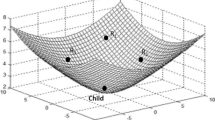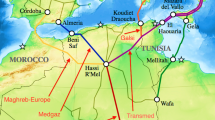Abstract
This paper presents an evolutionary approach-based solution of multi-objective transportation-p-facility location problem (MOT-p-FLP) that minimizes overall transportation time, cost of transportation, and carbon emission (CE) from available sites to facility sites by seeking transported product quantities and the facility locations in the Euclidean plane. Genetic algorithm (GA), non-dominated sorting genetic algorithm (NSGA-II and NSGA-III), and modified Self-Adaptive Multi-Population Elitism Jaya Algorithm (SAMPE JA) are utilized to solve the problem. We compared obtained compromise solutions of the problem by evolutionary algorithms with population size, the maximum number of generations, crossover probability, mutation probability, and computational time. Sensitivity analysis for supply, demand, and carbon cap parameters is incorporated in the model’s solution, which helps the decision maker make the appropriate decision. These evolutionary algorithms (NSGA-II and NSGA-III) give Pareto-optimal solutions, and it helps management decide on the selection of p-facility locations. They could transport their product to the facility locations easily, with minimum transport, CE costs, and transportation time. As a result, management can give equal attention to their profit and environment, which helps to build world market credibility. At last, the paper concludes the results.



Similar content being viewed by others
References
Ardestani-Jaafari A, Delage E (2018) The value of flexibility in robust location-transportation problems. Transp Sci 52(1):189–209
Carlo HJ, David V, Salvat-Dávila GS (2017) Transportation-location problem with unknown number of facilities. Comput Ind Eng 112:212–220
Chikumbo O, Goodman E, Deb K (2012) Approximating a multi-dimensional pareto front for a land use management problem: a modified MOEA with an epigenetic silencing metaphor. In: 2012 IEEE congress on evolutionary computation. IEEE, pp 1–9
Das SK, Roy SK (2019) Effect of variable carbon emission in a multi-objective transportation-p-facility location problem under neutrosophic environment. Comput Ind Eng 132:311–324
Deb K, Jain H (2013) An evolutionary many-objective optimization algorithm using reference-point-based nondominated sorting approach, part I: solving problems with box constraints. IEEE Trans Evol Comput 18(4):577–601
Deb K, Agrawal S, Pratap A, Meyarivan T (2000) A fast elitist non-dominated sorting genetic algorithm for multi-objective optimization: NSGA-II. In: International conference on parallel problem solving from nature. Springer, Berlin, pp 849–858
Deshmukh M, Moorthy CB (2010) Application of genetic algorithm to neural network model for estimation of wind power potential. Methods 11:12
Du S, Tang W, Song M (2016) Low-carbon production with low-carbon premium in cap-and-trade regulation. J Clean Prod 134:652–662
Elhedhli S, Merrick R (2012) Green supply chain network design to reduce carbon emissions. Transp Res Part D Transp Environ 17(5):370–379
Farahani RZ, SteadieSeifi M, Asgari N (2010) Multiple criteria facility location problems: a survey. Appl Math Model 34(7):1689–1709
Fu G, Kapelan Z, Kasprzyk JR, Reed P (2013) Optimal design of water distribution systems using many-objective visual analytics. J Water Resour Plan Manag 139(6):624–633
Gabrel V, Lacroix M, Murat C, Remli N (2014) Robust location transportation problems under uncertain demands. Discret Appl Math 164:100–111
Goldberg DE, Holland JH (1988) Genetic algorithms and machine learning. Mach learn 3:95–99
Guo Y, Chen ZR, Ruan YL, Zhang J (2012) Application of NSGA-II with local search to multi-dock cross-docking sheduling problem. In: 2012 IEEE international conference on systems, man, and cybernetics (SMC). IEEE, pp 779–784
Harris I, Mumford CL, Naim MM (2014) A hybrid multi-objective approach to capacitated facility location with flexible store allocation for green logistics modeling. Transp Res Part E Logist Transp Rev 66:1–22
Hitchcock FL (1941) The distribution of a product from several sources to numerous localities. J Math Phys 20(1–4):224–230
Holland J (1975) Adaptation in natural and artificial systems: an introductory analysis with application to biology. In: Control and artificial intelligence, pp 1–19
Klibi W, Lasalle F, Martel A, Ichoua S (2010) The stochastic multiperiod location transportation problem. Transp Sci 44(2):221–237
Mahapatra DR, Roy SK, Biswal MP (2013) Multi-choice stochastic transportation problem involving extreme value distribution. Appl Math Model 37(4):2230–2240
Maity G, Roy SK, Verdegay JL (2016) Multi-objective transportation problem with cost reliability under uncertain environment. Int J Comput Intell Syst 9(5):839–849
Martínez-Vargas A, Domínguez-Guerrero J, Andrade ÁG, Sepúlveda R, Montiel-Ross O (2016) Application of NSGA-II algorithm to the spectrum assignment problem in spectrum sharing networks. Appl Soft Comput 39:188–198
Oreski S, Oreski D, Oreski G (2012) Hybrid system with genetic algorithm and artificial neural networks and its application to retail credit risk assessment. Expert Syst Appl 39(16):12605–12617
Phanden R, Demir H, Gupta R (2018) Application of genetic algorithm and variable neighborhood search to solve the facility layout planning problem in job shop production system. In: 2018 7th international conference on industrial technology and management (ICITM). IEEE, pp 270–274
Ramesh S, Kannan S, Baskar S (2012) Application of modified NSGA-II algorithm to multi-objective reactive power planning. Appl Soft Comput 12(2):741–753
Rao RV (2019) Jaya: an advanced optimization algorithm and its engineering applications. Springer International Publishing, New York City, pp 1–58
Roy SK, Maity G, Weber GW, Gök SZA (2017) Conic scalarization approach to solve multi-choice multi-objective transportation problem with interval goal. Ann Oper Res 253(1):599–620
Sabbagh MS, Ghafari H, Mousavi SR (2015) A new hybrid algorithm for the balanced transportation problem. Comput Ind Eng 82:115–126
Saif A, Elhedhli S (2016) A Lagrangian heuristic for concave cost facility location problems: the plant location and technology acquisition problem. Optim Lett 10(5):1087–1100
Schaffer JD (1986) Some experiments in machine learning using vector evaluated genetic algorithms (artificial intelligence, optimization, adaptation, pattern recognition). Vanderbilt Univ., Nashville, TN (USA), pp 1–55
Soyel H, Tekguc U, Demirel H (2011) Application of NSGA-II to feature selection for facial expression recognition. Comput Electr Eng 37(6):1232–1240
Srinivas N, Deb K (1994) Muiltiobjective optimization using nondominated sorting in genetic algorithms. Evol Comput 2(3):221–248
Tsai CC, Huang HC, Chan CK (2011) Parallel elite genetic algorithm and its application to global path planning for autonomous robot navigation. IEEE Trans Ind Electron 58(10):4813–4821
Turken N, Carrillo J, Verter V (2017) Facility location and capacity acquisition under carbon tax and emissions limits: to centralize or to decentralize? Int J Prod Econ 187:126–141
Vikhar PA (2016) Evolutionary algorithms: a critical review and its future prospects. In: 2016 International conference on global trends in signal processing, information computing and communication (ICGTSPICC). IEEE, pp 261–265
Wang S, Zhao D, Yuan J, Li H, Gao Y (2019) Application of NSGA-II algorithm for fault diagnosis in power system. Electr Power Syst Res 175:105893
Wu P, Jin Y, Shi Y, Shyu H (2017) The impact of carbon emission costs on manufacturers’ production and location decision. Int J Prod Econ 193:193–206
Yeh WC, Chuang MC (2011) Using multi-objective genetic algorithm for partner selection in green supply chain problems. Expert Syst Appl 38(4):4244–4253
Zitzler E, Thiele L (1998) Multiobjective optimization using evolutionary algorithms—a comparative case study. In: International conference on parallel problem solving from nature. Springer, Berlin, pp 292–301
Author information
Authors and Affiliations
Corresponding author
Ethics declarations
Conflict of interest
The authors declare that they have no conflict of interest.
Ethical approval
This article does not contain any studies with human participants or animals performed by any of the authors.
Additional information
Communicated by .
Publisher's Note
Springer Nature remains neutral with regard to jurisdictional claims in published maps and institutional affiliations.
Rights and permissions
About this article
Cite this article
Vansia, D.O., Dhodiya, J.M. Solution of multi-objective transportation-p-facility location problem with effect of variable carbon emission by evolutionary algorithms. Soft Comput 25, 9993–10005 (2021). https://doi.org/10.1007/s00500-021-05619-2
Published:
Issue Date:
DOI: https://doi.org/10.1007/s00500-021-05619-2




